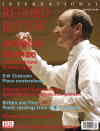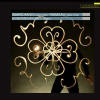Texte paru dans: / Appeared in:
*

International Record Review - (04/2012)
Pour
s'abonner / Subscription information
Ambronay
AMY032

3760135100323
Consultez toutes les évaluations recensées pour ce cd
~~~~ Reach all the evaluations located for this CD
Lyon is the common factor here. Harpsichordist Louis Marchand was born and studied the organ in the city; Rameau too lived and composed his grands motets here around 1713; and it was in Lyon that Pierre Donzelague built the magnificent two-manual harpsichord which Christophe Rousset has very appropriately selected for this recital. All recorded, of course, in Lyon, at the Decorative Arts Museum where the harpsichord is now housed. This makes for a very satisfying journey into the French Baroque, all the more so because Marchand doesn’t get out as often as he should these days. I’ve heard plenty of recitals in which one or two of his pieces feature prominently, but his complete suites are much less often heard than they deserve.
So lets start with Louis Marchand (1669- 732), which is not quite as straightforward as it sounds. Such was the proliferation of the musical Marchands that it’s easy to get confused. During the first half of the eighteenth century there were, for example, no fewer than four of them working at Versailles, all of whom shared exactly the same forename — Jean-Noël. Louis, from a different branch of the family, is best distinguished as the royal organist and harpsichordist who took Paris by storm in the latter part of Louis XIV’s reign but rather lost his nerve when faced with a musical duel with Johann Sebastian Bach in Dresden in 1717. His solution? Run away. But then he’d already run away to Germany to avoid the legal pursuit of his wife, to whom he had shamefully often raised his hand. Yes, there are tales aplenty about his lax lifestyle and underhand dealings but they need concern us only in as far as Marchand’s diffidence extended to the publication of his music.
His only two collections for the harpsichord, issued in 1699 and 1702 (and both recorded by Rousset), contain a mere single suite each, and in addition to this there’s just a smattering of individual movements which have fortuitously survived elsewhere (all included here) . Rameau, of course, was a much more solid chap, and we meet him as a fresh-faced 23-year- old in his first harpsichord suite published in 1706 before he’d written a note of the magnificent theatrical music which was to make his career.
What comes as a slight surprise from two such colourful figures is that their suites are really rather well behaved: after a free Prélude they basically follow the classic pattern of French dances suites: allemande, courante, sarabande, gigue plus a few optional movements. Though Marchand lived well into the time of Louis XV, his musical language breathes the air of Louis XIV. He employs a constant twitter of ornaments which keeps the strings in almost perpetual vibration, giving the impression of great richness of sound and sustaining power which is augmented by his preference for medium-low registers rather than the higher, more sparkling treble we hear in Rameau. In these performances, Rousset plays up this difference nicely, registering the harpsichord so that the greater richness and bombast of Marchand contrasts vividly with the clearer textures but greater harmonic interest of his younger colleague.
In general, Rousset is much more poised, more moderate in his tempos and rather less impetuous than he was earlier in his career (as in the complete Rameau suites he recorded for L’Oiseau-Lyre (435 886-2) in 1989, for example). Can it be that middle age has brought with it greater thoughtfu1nes and a less urgent need to instantly impress? Maybe. But these are still performances which dazzle in their fast movements and draw one into the slower-paced ones. The first of Marchand’ s suites makes the strongest impression on this disc, with Rousset’s purposeful delicacy in the Allemande, a noisy Gigue and, best of all, a thrilling account of the big Chaconne which releases all the cumulative power and striding majesty of one of Marchand’s finest creations. In the Second Suite Rousset’s graceful touch is to the fore, especially in the beautiful, connective legato with which he contrasts Menuet I from its more bumptious twin. By including the single movement Vénitienne which Marchand contributed to a separate publication in 1706, we are able to make a revealing comparison with Rameau’s piece of the same name included in his First Suite.
Marchand’ s complete harpsichord works are
so rich and rewarding in Rousset’s hands that we really do regret the
composer’s disinclination to publish. Perhaps we should be most grateful for
the survival of Donzelague’s harpsichord of 1716 one of only a dozen such
instruments from this period which are both named and dated. Rousset recalls
in his booklet notes that it was rescued and restored for posterity when he
was still a student. His unusual five-octave range is put to excellent use
here, though its full colour and character are never quite realized by the
necessarily close, bright and slightly room-bound recording — well, the
instrument is in a museum, after all. Overall, though, a splendid release.
Fermer la fenêtre/Close window
Cliquez l'un ou l'autre
bouton pour découvrir bien d'autres critiques de CD
Click either button for many other reviews


